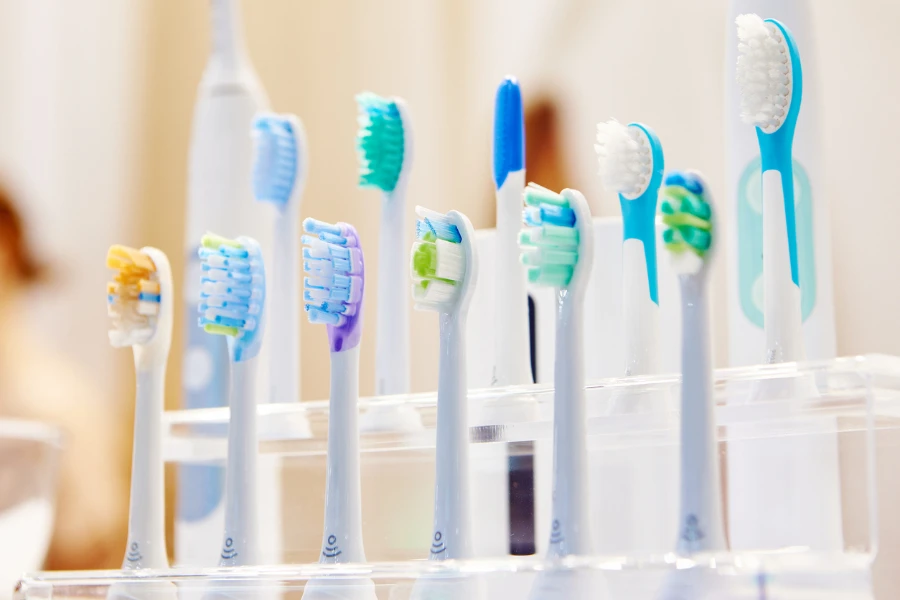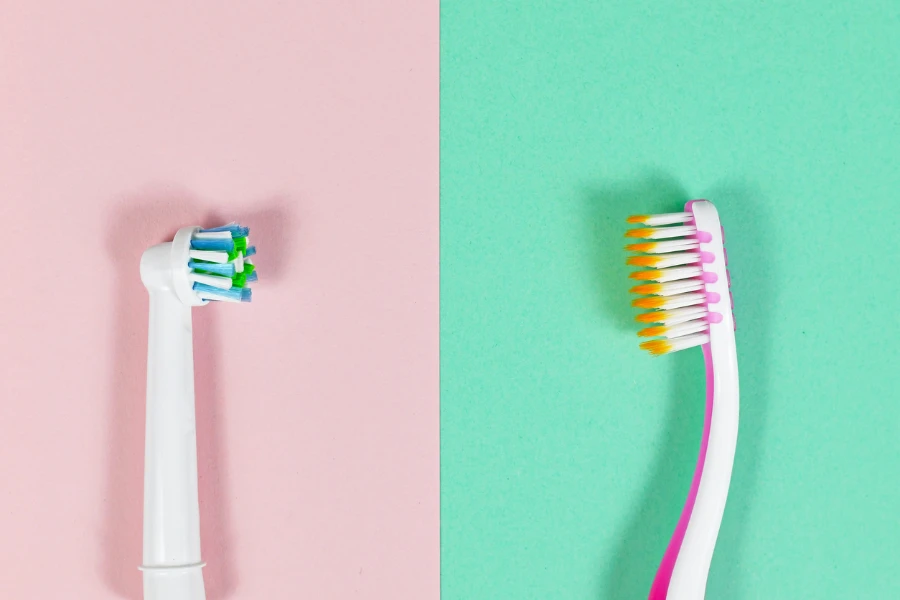Today’s consumers are astute and will prefer technologically advanced products over those that do not embrace technology. The electric toothbrush, quickly gaining popularity among customers, is one product that uses current advanced technology, such as sonic vibration, to meet various oral care needs.
As electric toothbrushes enter the market, businesses unfamiliar with sourcing the product may have difficulties obtaining them. This guide will provide professional sourcing guidance for electric toothbrushes, highlighting crucial market insights and key features for informed decision-making.
Table of Contents
Overview of the global electric toothbrush market
Types of electric toothbrushes
How to select an electric toothbrush
Bottom line
Overview of the global electric toothbrush market
Estimates for the global market for electronic toothbrushes placed the market value at US $4.6 billion in 2023, and experts project a compound annual growth rate (CAGR) of 7.8% to reach US $9.8 billion by 2033. North America and Europe are the two largest markets for electric toothbrushes. However, Asia-Pacific is anticipated to have the highest CAGR (up to 10%) between 2023 and 2032.
Various factors contribute to the growth of the electronic toothbrush market, including increased consumer awareness of innovative oral health and hygiene and a shift in customer preferences for easy and efficient oral care products. Other growth factors include the rising prevalence of dental problems, boosting demand for effective oral care solutions, and an increasing consumer preference for more technologically advanced items.
One of the most popular electric toothbrush trends is using AI to provide the greatest possible cleaning. AI recommends and identifies your brushing style and includes advice on brushing techniques. Another trend involves toothbrush manufacturers and dental specialists working together to develop reliable and efficient dental products, such as electric toothbrushes.
Users of electronic toothbrushes include tech-savvy consumers, health-conscious individuals seeking advanced oral care solutions, and people with limited dexterity who require effective oral care products. Colgate-Palmolive Company, Church & Dwight, Philips Sonicare, Panasonic Holdings Corporation, and Procter & Gamble are among the industry’s key players.
Types of electric toothbrushes

Oscillating electric toothbrushes
The most popular electric toothbrush is the oscillating toothbrush, which cups each tooth and spins back and forth (oscillations). They may reach speeds of up to 8,800 strokes per minute.
Rotating electric toothbrushes
Oscillating and rotating toothbrushes are occasionally lumped together as oscillating-rotating toothbrushes. But they are a little different. Unlike oscillating toothbrushes, which brush back and forth, rotating electric toothbrushes employ a circular motion to remove plaque and debris from the teeth and gums.
Sonic toothbrushes

Sonic electric toothbrushes generate high-frequency vibrations that loosen debris and plaque from the teeth. With a maximum vibration rate of 40,000 strokes per minute, sonic toothbrushes function significantly faster than rotating or oscillating brushes. The high-speed vibrations provide an intense yet gentle fluid action that cleans the teeth and gumline without damaging the gums.
Ultrasonic toothbrushes
While sonic toothbrushes use sound vibrations and physical action, ultrasonic toothbrushes solely use high-intensity sonic vibrations. The ultrasonic vibrations create millions of tiny bubbles in the mouth, disrupting plaque and bacteria.
The user of an ultrasonic toothbrush must concentrate brush pressure on each tooth location for a specific duration of time, as the brush bristles do not have any built-in physical movement. These toothbrushes bog down if too much pressure is applied, reducing the danger of gum recession while providing a deep clean without harsh action.
U-shaped electric toothbrushes
The U-shaped electric toothbrush can have the same functionality as sonic, ultrasonic, oscillating, or rotating electric toothbrushes. However, its U-shape fits the mouth well, making it easy to use. It cleans various teeth at once, and there is no need to point the toothbrush to a specific tooth.
Bluetooth/WiFi-enabled toothbrushes
Some electric toothbrushes support Bluetooth, but not all of them. Bluetooth connectivity is often dependent on the electric toothbrush’s model and brand. A Wi-Fi- or Bluetooth-enabled toothbrush links to an app while brushing and shows a 3D map of the mouth on a phone screen to assist the user in reaching every nook and cranny. Furthermore, it tracks brushing behaviors and provides individualized oral care advice, product announcements, and innovative brushing techniques.
Most electric toothbrushes include removable and interchangeable brush heads, allowing consumers to personalize their cleaning experience.
How to select an electric toothbrush
When choosing electric toothbrushes to sell, the following aspects must be addressed to guarantee that they satisfy the client’s preferences and oral care demands:
Brushing technology
As previously stated, electric toothbrushes use various brushing and efficacy technologies: rotating, oscillating, sonic, and ultrasonic. Some toothbrushes have advanced features like Bluetooth or Wi-Fi connectivity and associated apps or devices that users might find helpful. LED electric toothbrushes with multiple colors to match different moods are also an option for consumers.
End-user

It is critical to examine the age and other characteristics of the electric toothbrush user. For example, electric toothbrushes for children include smaller brush heads, softer bristles, and colorful designs to make brushing more enjoyable. Keeping electric toothbrushes for both adults and children in stock should be the goal for any businessperson.
Brushing modes and features
Like other technological devices, electric toothbrushes have various modes and additional functionality. These toothbrushes are designed for daily cleaning and sensitive teeth and gums, so ensuring they have extra features, such as pressure sensors and timers, is essential for effective and tailored oral care. Some electronic toothbrushes come with electric power flossers.
A good electric toothbrush is compatible with various brush head options and accommodates different preferences and needs. The toothbrush’s battery life and charging options, such as wireless charging, USB charging, Bluetooth charging, and charging stands, also matter.
Ease of use and comfort
A good electric toothbrush is easy to use and feels comfortable. The toothbrush should also feature an ergonomic design in that the handle should be easy to use and fit the hand without harming it. Furthermore, the toothbrush should have soft bristles that do not hurt the gums. Considering the size and weight of the toothbrush, especially for people with dexterity issues or children, is also paramount when choosing electronic toothbrushes.
Price and quality
The consumer’s budget should always be considered when purchasing electric toothbrushes. It is critical to compare pricing across brands and models to determine whether there are any savings. However, it is vital not to sacrifice an electric toothbrush’s quality for a lower price.
That is why sellers should strive to strike a balance between quality and price when purchasing electric toothbrushes to resell.
Bottom line
Electric toothbrushes are becoming more popular among tech-savvy consumers, increasing demand and market growth. The five most common electric toothbrushes are oscillating, rotating, sonic, ultrasonic, and Bluetooth-enabled. Each has unique characteristics, with the primary distinctions being vibration speed and type of spin.
When sourcing electric toothbrushes, paying close attention to the brushing technology, end user, brushing modes, convenience of use, and affordability is crucial. That is it. You can now go ahead and get your clients electric toothbrushes.




